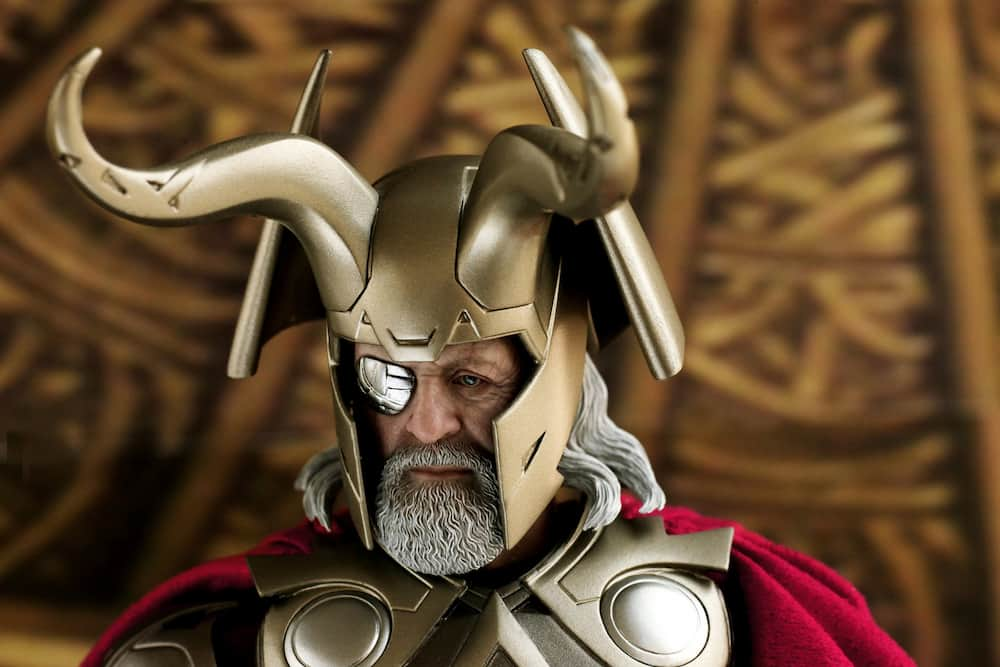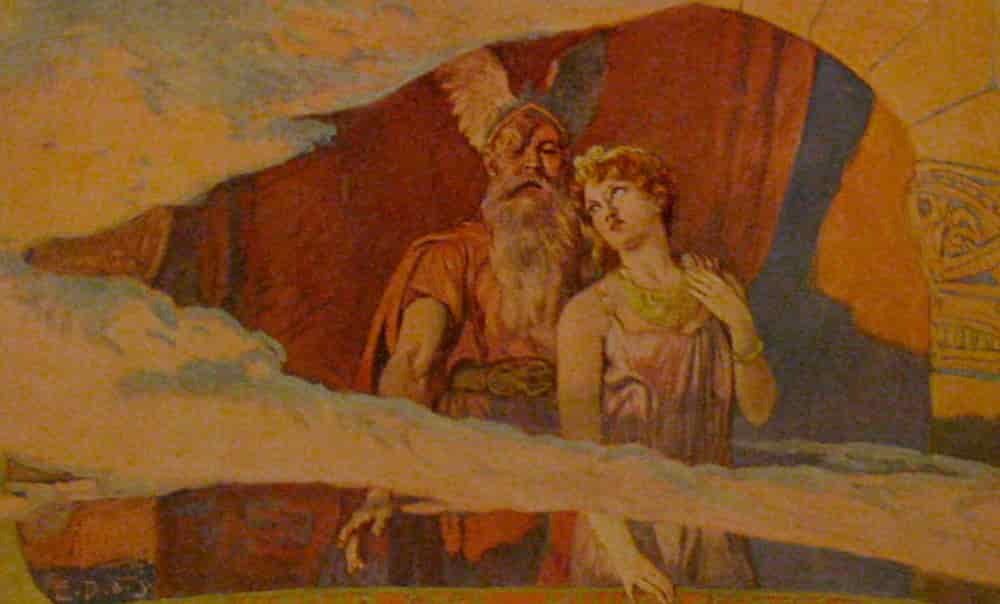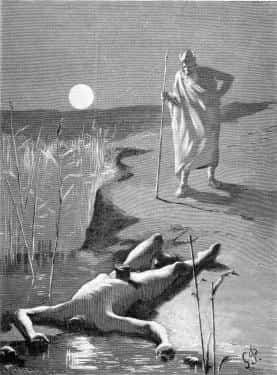The stories of Odin, the Allfather of the Viking gods, show how the divine leader was willing to sacrifice everything in the line of duty. Notably, his missing eye is one of the more notable features that distinguish the ruler of Valhalla.
But how did Odin lose his eye? Keep reading to find out, as the way that such a valiant warrior lost an eye might surprise you.

Table of Contents
How did Odin lose his eye?
As a leader, Odin was always on the hunt for more knowledge and power. Odin lost his eye as part of a trade deal that gave him access to a well underneath the world tree, Yggdrasil, that was full of divine wisdom.
(Quick comment on the sources of this information: Knowledge of Odin’s sacrifice comes primarily from the Poetic Edda‘s Voluspo (or Voluspa), the Prose Edda‘s Gylfaginning, and the Ynglinga Saga of the Heimskringla. Icelandic historian Snorri Sturlson compiled all of these works in the early half of the 13th century, placing them after the Viking Age.
While much closer to the time of pagan belief in Scandinavia, it’s clear that Christianity has a major influence on the text, such as the inclusion of Adam and Eve and Noah’s Ark in the Prologue of the Prose Edda.)
The vast world of Norse mythology was full of secret lairs that contained deep and ancient magic. Mimisbrunnr, a well at the root of Yggdrasil, was one such place. The waters of the well could grant wisdom with a drink, but it was guarded by a water spirit named Mimir who was included among the Aesir, the key Norse pantheon of the Asa.
Thither came Allfather and craved one drink of the well; but he got it not until he had laid his eye in pledge
Prose Edda, Gyfalginning
Odin somehow learned about the existence of the well, and he went to ask Mimir for a drink from it. Mimir didn’t let Odin take a drink from the well without first offering something in return. It’s unclear if Mimir asked for the eye or if Odin offered it as an acceptable sacrifice for such a profound gift.

Either way, the deal was accepted, and Odin gave his eye to Mimir. From that day until his death at Ragnarok, Odin only has the vision of one eye, but his wisdom allows him to see much further than even the sharpest eyes amongst the Aesir.
Related: Odin’s Horn: The Meaning and History of this Viking Symbol
Which eye did Odin lose?
The ancient texts of Snorri Sturlson do not tell us which eye Odin traded for his wisdom. Whether that was a matter of dispute, assumed to be known, or simply a forgotten fact is uncertain. Depictions trend towards showing him with a missing right eye.
Few lines are spared for the story of Odin’s missing eye, but Snorri covered a vast number of myths and legends within his work. It’s possible that more stories that discuss Odin’s sacrifice were part of the mythos, but the curtain of time has shrouded the tales from view. Since Snorri offers no insights into which eye was given, it’s time to look at other depictions.
Artwork from the Viking Age is nearly as limited as the written works, but the Torslunda plates include a depiction of Odin that also has a missing right eye. From the physical evidence, the plate was originally made with both eyes in place, then further work removed the right eye.

A 16th century illustration by Olaus Magnus shows Odin on a throne with both of his eyes. From the 18th century, drawings of Odin inside the manuscript of Melsted’s Edda show Odin as missing his right eye, although one is from the left with no view of his right side.
The side-view with the obvious intent of an empty right eye lends support to the idea that the left-facing depiction of Odin from the past was also keeping the lost eye from view.

After Wagner released his series of plays, Der Ring des Nibelungen or The Rings of Nibelung, Norse iconography saw a resurgence in the art of the late 19th and early 20th centuries. The placement of Odin’s lost eye was more inconsistent in this period, and many depictions don’t include a missing eye at all.
For an example that doesn’t have a missing eye, look at Lorenz Froelich’s The Sacrifice of Odin. Emil Doepler’s depiction of Wodan (Odin) and Frea shows Odin with an eyepatch over the right eye.

In the most popular modern depictions of Odin, the missing eye’s location tends to fall on the right side, but it isn’t absolute. In the primary universe of Marvel’s comic multiverse, which is also where the Marvel Cinematic Universe takes place, Odin’s right eye is missing.
There are a potentially endless number of other universes in the Marvel stories, and some of the other Odins are missing the opposite eye, such as the Odin from Earth-14412.
You may also be interested in: Until Valhalla: What Does It Mean (and is it “Til Valhalla”)?
Who removed Odin’s eye?
Technically, Odin was the one who removed his own eye. When he went to the well under Yggdrasil, Odin either offered it up on his own or was asked for it in exchange for a single drink from Mimir’s well of wisdom.
Odin’s eye was not taken by force. The Allfather went to Mimisbrunnr of his own will, and he either accepted the deal offered by Mimir or volunteered his own eye.
With the bravery of a warrior and a ruler, he pulled his eye out of its socket and laid it in front of Mimir to get just one drink from the well.
Why did Mimir want Odin’s eye?
The eddas do not tell us why Mimir asked for Odin’s eye or accepted it as a trade, except that it was the price demanded for a drink from the well of wisdom under his care. After receiving the eye, he used it as a drinking receptacle for mead.
I know where Othin’s | eye is hidden,
Deep in the wide-famed | well of Mimir;
Mead from the pledge | of Othin each mom
Does Mimir drink: | would you know yet more?
Poetic Edda, Voluspo, stanza 29
An eye doesn’t seem like a particularly good drinking vessel, so it’s hard to say whether there is a particular reason that Odin’s eye looked like a drinking vessel or if Mimir was just looking for a use for an odd but important display of Odin’s resolve.
How did Mimir lose his eye?
Mimir did not lose either of his eyes, but he did end up losing his head, according to the confusing mixture of available stories. Odin kept the severed head of Mimir after preserving it with herbs and magic, allowing Mimir to continue dispensing wisdom to Odin instead of perishing.
The Ynglinga saga tells about the adventures of the Aesir in their mortal forms, and it is analogous in many ways to the overall mythos, with a few slightly different details. In both the mortal and divine versions, a war occurs between the Aesir, or the group of gods ruled by Odin, and another group of gods called the Vanir.

The fighting was fierce, and the two sides eventually came to a peace agreement. As part of the deal, there was an exchange of prisoners in gilded cages. The Aesir sent Hoenir (Hone) and Mimir (Mime).
Hoenir was supposed to be the key of the deal, but Vanir eventually noticed that his wisdom was lacking whenever Mimir wasn’t around.
… the Vanaland people got a suspicion that the Asaland people had deceived them in the exchange of men. They took Mime, therefore, and beheaded him, and sent his head to the Asaland people.
The Ynglinga Saga
For most people, losing their head is the end of their story. Mimir’s decapitated cranium was preserved by Odin through the power of both magic and herbs, allowing it to continue dispensing wisdom past the expiration of his body.
Here is where the slight confusion of Mimir’s fate begins. Note that Mim is generally taken to be another name for Mimir, just as Mime is.
Yggdrasil shakes, | and shiver on high
The ancient limbs, | and the giant is loose;
To the head of Mim | does Othin give heed,
But the kinsman of Surt | shall slay him soon.
Poetic Edda, Voluspo, stanza 47
The skald Harr references this event in the Gylfaginning, but it is clear that they believe Mimir to still be at his well according to a line shortly before the above stanza is quoted. In the events of Ragnarok, Odin is supposed to ride to the well again and seek advice from the wise water spirit.
Then Odin shall ride to Mímir’s Well and take counsel of Mímir for himself and his host.
Prose Edda, Gylfaginning
Mimir is said to keep the well in a way that suggests an ongoing duty much earlier in the same text.
But under that root which turns toward the Rime-Giants is Mímir’s Well, wherein wisdom and understanding are stored; and he is called Mímir, who keeps the well.
Prose Edda, Gylfaginning
Shifting given names over time and the tendency for the skalds to use poetic naming may make it seem like there could be separate entities, but the overlapping references strongly suggest that Mim, Mime, and Mimir are all the same.
The only way that both stories can be true and reference the same character is if Odin placed Mimir’s head at the well’s location underneath Yggdrasil’s roots.
How a severed head continues to drink from an eyeball is not clear, either. An answer may be in the missing stories, but myths don’t necessarily need to make perfect sense, either.
That said, Mimir gained an eye instead of losing one, though he takes drinks from the new one instead of taking peeks with it.
What is the meaning of Odin’s sacrifice?
Odin gave up part of his vision to gain wisdom. Symbolically, the meaning of the sacrifice is fairly surface level: one must often make great sacrifices to gain great knowledge. The specific sacrifice of vision may also suggest that looking within instead of without can grant wisdom.
The surviving texts don’t spell out the meaning of this specific sacrifice, nor do they provide much information about the event in general.
On the surface, the story may have been intended to show that a good ruler must be willing to make sacrifices and must put a high value on wisdom. It would have been easy enough to create a story about Odin losing his eye in a glorious battle, but the Vikings chose to make him trade the eye away.

The idea of losing an eye in battle may also not have been as scary to a Viking as the thought of intentionally plucking it out on your own. One would be a painful but likely sudden consequence, while the other demands a serious commitment to overcoming their own self-preservation.
Vision and wisdom are also keenly related, both in Norse paganism and cultures around the world. Those who lose vision are often ascribed powers of foresight. Odin already had second sight from birth, but losing an eye could be seen as a natural sacrifice for gaining wisdom, in the mind of a Viking.
Odin also straddled the line between the world of magic and the world of warriors. Having one eye missing could have been a common vision of Odin due to his place within both fields, and the story of trading his eye for wisdom could be a story meant to explain its absence and codify it in the mythos.
Is Odin wise only because he sacrificed his eye?
The chronology of events in the Norse myths is not always clear, but it is evident that Odin showed wisdom from early on in his life and found ways to expand his wisdom beyond the drink from the well.
Aside from the drink from the well, Odin has other boosts to his Wisdom ability score. His inherent wisdom, allies, and gathered resources all combine to make Odin incredibly cognizant of every event, but no one factor alone would match up to the total package.
Odin is a long-lived being who avoids the ravages of time through magical apples. Being alive for an indeterminate amount of time with no aging offers plenty of chances to both have and learn from experiences.
He wisely fights the first frost giant (known as “Jötunn” in Norse mythology), Ymir, with the help of his brothers. When trying to steal the mead of poesy, he avoids a backstabbing attempt from the giant Baugi. Many more events could be listed to show his wisdom, as the Norse were very dedicated to honoring that aspect of Odin.

Not even the most omnipotent divine beings rely solely on their power though, and Odin’s strength has its limits. To help him rule over Asgard and his creation of Midgard, Odin employs two ravens named Huginn and Muninn.
Huginn’s name means “thought”, and Muninn’s means “memory”. The pair of birds are capable of traversing the world at great speeds, listening and watching the events that transpire. Then, they fly back to Odin’s shoulders and dispense with the information that they gathered.
Why can’t Odin regenerate his eye?
Although he has the powers of shapeshifting and runic magic, Odin is either unable to or unwilling to fix his missing eye. No specific reason is given, but it is possible that doing so is impossible or would invalidate his sacrifice and cost him the gained wisdom.
Odin frequently utilizes his powers of shapeshifting throughout his journeys, and many of those disguises don’t sport the same missing eye that might give him away.
The mortal Odin of the Ynglinga Saga’s prologue goes into a trance to shapeshift, but divine Odin seems to do so at will. He always returns to his primary form, though, so it’s likely that the changes are not permanent, even if he can replicate a missing eye when needed.
After hanging from the world tree for nine days, Odin gained the gift of runes, their true meaning, and the magic within them. While Norse runes like Uruz were known to the Vikings for having healing potential, the Merseburg Incantations show a direct example of Odin using runes for healing. In the incantation, his name is given as Wodan, a common linguistic cognate of Odin.
Phol and Wodan rode into the woods,
There Balder’s foal sprained its foot.
It was charmed by Sinthgunt, her sister Sunna;
It was charmed by Frija, her sister Volla;
It was charmed by Wodan, as he well knew how:
Bone-sprain, like blood-sprain,
Like limb-sprain:
Bone to bone; blood to blood;
Limb to limb — like they were glued.
Second Merseburg Incantation
Thus, it was taken as a fact that Odin had healing magic, and the stories never say that he used it to restore his own eye. Regrowing a whole organ may have been beyond him, but it also could have simply taken another arrangement of runic magic.
The sacrificial eye is called “Valfather’s Pledge”, which is the best indication of why Odin has never recovered his full vision. Magic has a way of working against the user when the reasons are selfish or impure, and the eye was the symbol of his sacrifice.
To take back his pledge could have an impact on the magical aspect of his wisdom, and he had already made up his mind to give up the eye for knowledge. Others who knew of his pledge may also lose their trust in his word.
Ultimately, even if Odin could regain his eye, he wouldn’t do so if it jeopardized the wisdom he gained from the deal and the strength of his rule. The Allfather will continue to watch over Midgard with one eye and endless wisdom until he disappears into Fenrir’s jaws.
